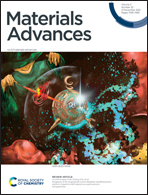An organic–inorganic hybrid double perovskite-type cage-like crystal (MA)2KBiCl6 (MA = methylammonium cation) with dielectric switching behavior†
Abstract
An organic–inorganic hybrid double perovskite-type cage-like crystal, (MA)2KBiCl6 (MA = methylammonium cation, 1), was synthesized. It undergoes structural phase transitions at 336/326 K (heating/cooling). Variable-temperature single-crystal structural analyses reveal that the change of the dynamics of the MA and the deformation of the anionic cage-like framework contribute to the structural phase transition. This order–disorder transition of the MA causes dielectric transitions between the low- and high-dielectric states, making it a type of switchable dielectric material. Furthermore, dielectric anisotropic properties and reversibility of the dielectric switching of this crystal under temperature stimuli are also identified. The results reveal that hybrid double perovskite-related halides provide a promising platform for achieving switchable dielectric properties, and more hybrid perovskites can be prepared by using different organic amines as the A-site cation.



 Please wait while we load your content...
Please wait while we load your content...